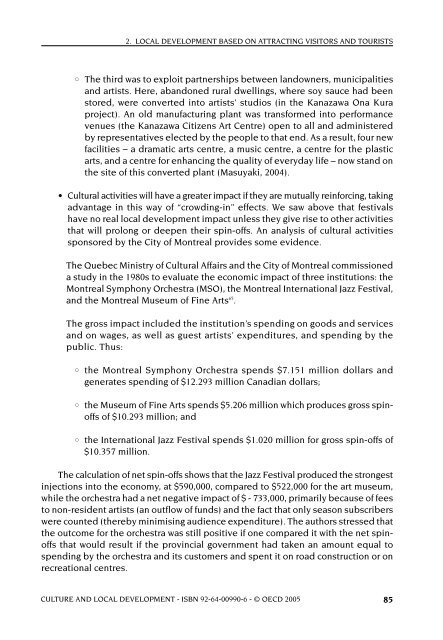OECD Culture and Local Development.pdf - PACA
OECD Culture and Local Development.pdf - PACA
OECD Culture and Local Development.pdf - PACA
Create successful ePaper yourself
Turn your PDF publications into a flip-book with our unique Google optimized e-Paper software.
2. LOCAL DEVELOPMENT BASED ON ATTRACTING VISITORS AND TOURISTS<br />
• The third was to exploit partnerships between l<strong>and</strong>owners, municipalities<br />
<strong>and</strong> artists. Here, ab<strong>and</strong>oned rural dwellings, where soy sauce had been<br />
stored, were converted into artists’ studios (in the Kanazawa Ona Kura<br />
project). An old manufacturing plant was transformed into performance<br />
venues (the Kanazawa Citizens Art Centre) open to all <strong>and</strong> administered<br />
by representatives elected by the people to that end. As a result, four new<br />
facilities – a dramatic arts centre, a music centre, a centre for the plastic<br />
arts, <strong>and</strong> a centre for enhancing the quality of everyday life – now st<strong>and</strong> on<br />
the site of this converted plant (Masuyaki, 2004).<br />
• Cultural activities will have a greater impact if they are mutually reinforcing, taking<br />
advantage in this way of “crowding-in” effects. We saw above that festivals<br />
have no real local development impact unless they give rise to other activities<br />
that will prolong or deepen their spin-offs. An analysis of cultural activities<br />
sponsored by the City of Montreal provides some evidence.<br />
The Quebec Ministry of Cultural Affairs <strong>and</strong> the City of Montreal commissioned<br />
a study in the 1980s to evaluate the economic impact of three institutions: the<br />
Montreal Symphony Orchestra (MSO), the Montreal International Jazz Festival,<br />
<strong>and</strong> the Montreal Museum of Fine Arts 65 .<br />
The gross impact included the institution’s spending on goods <strong>and</strong> services<br />
<strong>and</strong> on wages, as well as guest artists’ expenditures, <strong>and</strong> spending by the<br />
public. Thus:<br />
• the Montreal Symphony Orchestra spends $7.151 million dollars <strong>and</strong><br />
generates spending of $12.293 million Canadian dollars;<br />
• the Museum of Fine Arts spends $5.206 million which produces gross spinoffs<br />
of $10.293 million; <strong>and</strong><br />
• the International Jazz Festival spends $1.020 million for gross spin-offs of<br />
$10.357 million.<br />
The calculation of net spin-offs shows that the Jazz Festival produced the strongest<br />
injections into the economy, at $590,000, compared to $522,000 for the art museum,<br />
while the orchestra had a net negative impact of $ - 733,000, primarily because of fees<br />
to non-resident artists (an outflow of funds) <strong>and</strong> the fact that only season subscribers<br />
were counted (thereby minimising audience expenditure). The authors stressed that<br />
the outcome for the orchestra was still positive if one compared it with the net spinoffs<br />
that would result if the provincial government had taken an amount equal to<br />
spending by the orchestra <strong>and</strong> its customers <strong>and</strong> spent it on road construction or on<br />
recreational centres.<br />
CULTURE AND LOCAL DEVELOPMENT - ISBN 92-64-00990-6 - © <strong>OECD</strong> 2005 85














